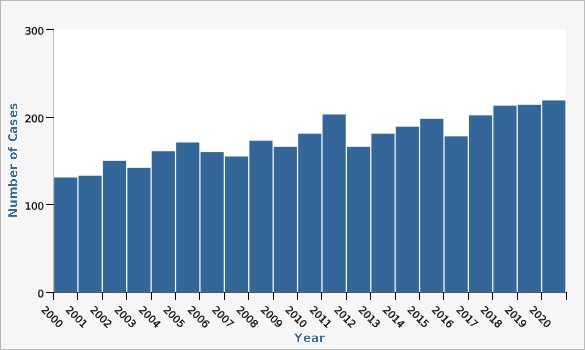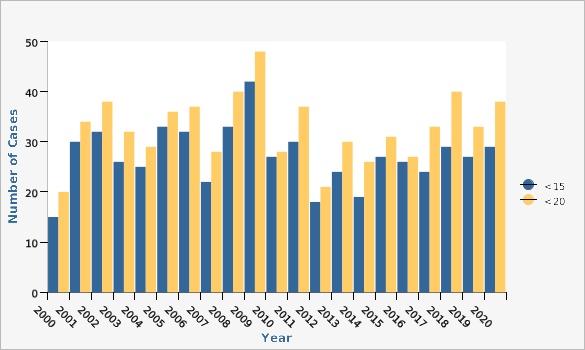Complete Health Indicator Report of Cancer of the Brain and Central Nervous System
Definition
The rate of incidence of invasive cancer of the brain and central nervous system (ICD-10: C71-72) in Utah per 100,000 population.Numerator
The number of incidents of invasive cancer of the brain and central nervous system among Utah population for a given time period (ICD-10: C71-72).Denominator
Population of Utah for a specific period of time.Data Interpretation Issues
Incidence rates may vary from source to source. This may be due to provisional data or using different population databases. Cancer diagnoses in 2020 may be impacted by the COVID-19 pandemic due to the changes in health services and cancer screening accessibility.Why Is This Important?
The brain and spinal cord make up the central nervous system (CNS). Brain and spinal cord tumors can occur in both adults and children, and some are more common in children. There are many different types of brain and CNS tumors, including both benign (noncancerous) and malignant (cancerous) tumors, but the data presented here only include malignant tumors. The exact causes of brain and CNS tumors are not known. Possible causes include viruses, defective genes, exposure to certain chemicals and other hazardous materials, and immune system disorders. Brain tumors occur more often in males than females and are most common in middle to older age persons^1^. Symptoms can vary depending upon the tumor type, location, size, and how fast it grows. This can make it difficult to detect brain and CNS tumors.[[br]] [[br]] ---- 1. [https://www.ninds.nih.gov/health-information/disorders/brain-and-spinal-cord-tumors]Related Indicators
Related Relevant Population Characteristics Indicators:
Graphical Data Views
Brain and Central Nervous System Cancer Number of Cases by Year, Utah, 2000-2020

| Year | Number of Cases | |||||
|---|---|---|---|---|---|---|
Record Count: 21 | ||||||
| 2000 | 131 | |||||
| 2001 | 133 | |||||
| 2002 | 150 | |||||
| 2003 | 142 | |||||
| 2004 | 161 | |||||
| 2005 | 171 | |||||
| 2006 | 160 | |||||
| 2007 | 155 | |||||
| 2008 | 173 | |||||
| 2009 | 166 | |||||
| 2010 | 181 | |||||
| 2011 | 203 | |||||
| 2012 | 166 | |||||
| 2013 | 181 | |||||
| 2014 | 189 | |||||
| 2015 | 198 | |||||
| 2016 | 178 | |||||
| 2017 | 202 | |||||
| 2018 | 213 | |||||
| 2019 | 214 | |||||
| 2020 | 219 | |||||
Data Notes
Invasive cancers only; ICD-10: C71-72.Data Source
Cancer data provided by the Utah Cancer Registry, supported by the National Cancer Institute (HHSN261201800016I), the U.S. Center for Disease Control and Prevention (NU58DP0063200), the University of Utah, and Huntsman Cancer FoundationBrain and Central Nervous System Cancer Number of Cases in Children (<15 and <20 years), Utah, 2000-2020

| Age <15 vs <20 | Year | Number of Cases | ||||
|---|---|---|---|---|---|---|
Record Count: 42 | ||||||
| <15 | 2000 | 15 | ||||
| <15 | 2001 | 30 | ||||
| <15 | 2002 | 32 | ||||
| <15 | 2003 | 26 | ||||
| <15 | 2004 | 25 | ||||
| <15 | 2005 | 33 | ||||
| <15 | 2006 | 32 | ||||
| <15 | 2007 | 22 | ||||
| <15 | 2008 | 33 | ||||
| <15 | 2009 | 42 | ||||
| <15 | 2010 | 27 | ||||
| <15 | 2011 | 30 | ||||
| <15 | 2012 | 18 | ||||
| <15 | 2013 | 24 | ||||
| <15 | 2014 | 19 | ||||
| <15 | 2015 | 27 | ||||
| <15 | 2016 | 26 | ||||
| <15 | 2017 | 24 | ||||
| <15 | 2018 | 29 | ||||
| <15 | 2019 | 27 | ||||
| <15 | 2020 | 29 | ||||
| <20 | 2000 | 20 | ||||
| <20 | 2001 | 34 | ||||
| <20 | 2002 | 38 | ||||
| <20 | 2003 | 32 | ||||
| <20 | 2004 | 29 | ||||
| <20 | 2005 | 36 | ||||
| <20 | 2006 | 37 | ||||
| <20 | 2007 | 28 | ||||
| <20 | 2008 | 40 | ||||
| <20 | 2009 | 48 | ||||
| <20 | 2010 | 28 | ||||
| <20 | 2011 | 37 | ||||
| <20 | 2012 | 21 | ||||
| <20 | 2013 | 30 | ||||
| <20 | 2014 | 26 | ||||
| <20 | 2015 | 31 | ||||
| <20 | 2016 | 27 | ||||
| <20 | 2017 | 33 | ||||
| <20 | 2018 | 40 | ||||
| <20 | 2019 | 33 | ||||
| <20 | 2020 | 38 | ||||
Data Notes
Invasive cancers only; ICD-10: C71-72.Data Source
Cancer data provided by the Utah Cancer Registry, supported by the National Cancer Institute (HHSN261201800016I), the U.S. Center for Disease Control and Prevention (NU58DP0063200), the University of Utah, and Huntsman Cancer FoundationReferences and Community Resources
Brain and Spinal Cord Tumors @ [https://www.ninds.nih.gov/health-information/disorders/brain-and-spinal-cord-tumors] [[br]] Brain Tumors National Cancer Institute @ [https://www.cancer.gov/types/brain/patient/adult-brain-treatment-pdq] [[br]] American Cancer Society - Adult Information @ [https://www.cancer.org/cancer/types/brain-spinal-cord-tumors-adults.html][[br]] American Cancer Society - Child Information @ [https://www.cancer.org/cancer/types/brain-spinal-cord-tumors-children.html][[br]] Central Brain Tumor Registry of the United States @ [https://cbtrus.org/][[br]]More Resources and Links
Evidence-based community health improvement ideas and interventions may be found at the following sites:- Centers for Disease Control and Prevention (CDC) WONDER Database, a system for disseminating public health data and information.
- United States Census Bureau data dashboard.
- Utah healthy Places Index, evidence-based and peer-reviewed tool, supports efforts to prioritize equitable community investments, develop critical programs and policies across the state, and much more.
- County Health Rankings
- Kaiser Family Foundation's StateHealthFacts.org
- Medical literature can be queried at PubMed library.
Page Content Updated On 08/03/2023,
Published on 04/08/2024
